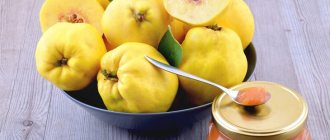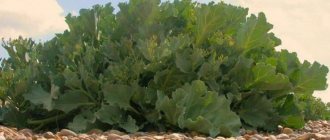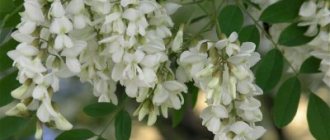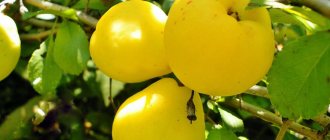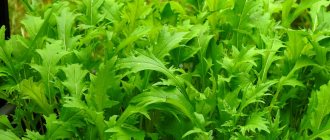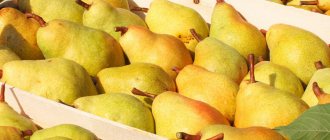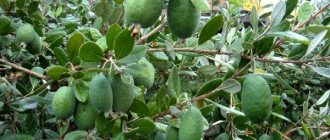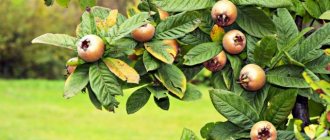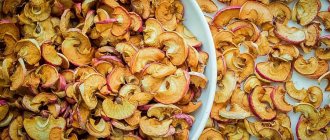Quince is not as widespread in our country as apples and pears, but in its composition and content of nutrients it is significantly superior to many traditional fruits. Therefore, many housewives stock up on these fruits in order to be able to consume them at any time. And for those who are just planning to stock up on them for the winter, it would be a good idea to learn how to store quinces at home.
How to choose
Harvesting should be done very carefully. Strong pressure on the fruits will cause them to rot. If the quince is not fully ripe, don’t worry. It will reach full maturity very quickly after being removed from the branch. And to speed up this process, fruits can be kept near pears or apples.
Harvesting should be done in clear weather, after the morning dew has dried.
If the quince does not grow on its own plot, they buy it. It is better to make purchases at the end of October, after full ripening.
When purchasing, the fruits are carefully inspected. In order for them to safely survive storage while remaining just as juicy, pay attention to the following things:
- the surface should be smooth and even, without stains or damaged areas;
- the skin of a ripe fruit should have a bright yellow color;
- The size of the fruit should be chosen large (in extreme cases - medium), since small quince can be sour and dry.
The duration of their preservation depends on the correct choice of fruits.
Benefits of quince fruits
The fruit of the quince is a false apple, spherical (Japanese variety) or pear-shaped. Color: lemon or dark yellow. When mature, the surface is smooth and hard. The fruit is large, reaching 15 cm in diameter.
Gardeners actively grow Japanese quince or Japanese chaenomeles. The fruits of this plant are smaller in size. The Japanese fruit reaches a diameter of about 4 cm.
Properties of pulp:
- aromatic;
- with a small content of juices;
- hard;
- taste - tart, astringent, sweetish.
Application in various fields
- Quince is a component of medications: for strengthening the body, diuretic, antiulcer and antibacterial effects.
- A variety of drinks and desserts are produced from the pulp.
- In folk medicine it is used to treat diseases of the respiratory tract and digestive system.
- Solutions are elements of various cosmetic preparations.
- Derivatives are used for processing fabrics in the textile industry.
Quince seeds are similar in shape and color to apple seeds. The seeds in the form of a decoction are used to reduce the local effect of other drugs and slow down their absorption, as well as as an expectorant.
Preparation for storage
Before storing quince for the winter, it is sorted. It is not advisable to wash it, so it is better to just gently wipe each fruit with a soft cloth.
- The shelf life of quince will increase if it is treated with wax or vegetable oil. But before using, the fruits should be washed thoroughly.
- Saving quinces works well in ordinary wooden boxes intended for vegetables and fruits. Ideally, boxes should have cells or partitions inside. But if this is not possible, it is advisable to sprinkle the fruits with sawdust or wrap each of them with paper or foil.
- There is a way to store quince, in which it is placed at the bottom of a box covered with paper in one layer. Then the fruit is covered with paper again and another layer is made.
- Fruits are inspected regularly. If spoiled or rotten specimens are found, they are thrown away.
Purchased quince
Not everyone has the opportunity to grow quince on their plot and wait for the harvest. However, this is not a problem at all, because it is not at all difficult to buy quince at the market or in any of the many stores.
It is best to purchase quince in the second half of October - early November, when the fruit ripens and is removed from the tree. When choosing, you must carefully follow the following rules:
- The fruit must have even and smooth skin, without bruises, scratches, rotten or moldy areas, otherwise it will not be stored for very long.
- When choosing fruits, you need to focus on the color - it should be rich lemon or yellow. This color indicates maturity.
- It is best to choose large or at least medium-sized fruits - often small quinces are sour, tasteless and dry.
Quince storage conditions
Storing quince at home is not very difficult. It is important to create the right temperature and humidity for it:
- storage temperature should be within 0°C -+2°C;
- air humidity – 80%;
- Be sure to store it in dark places.
Different types of these fruits, in different climatic zones, can remain fresh from 20 to 120 days. The fruit will not deteriorate at temperatures up to +8°C. But as the temperature rises, the shelf life of quince will also become shorter.
Fruit removal rules
The ripening period occurs in 2-7 weeks of autumn. The shelf life of quince depends on compliance with harvesting rules.
Recommendations for collecting quince from trees:
- You need to take the fruit carefully with your palm so as not to damage the peel and pulp with strong pressure or a scratch;
- After separation from the tree, the quince is placed one at a time, on a litter or in a special container;
- the optimal time is before noon, after the dew has evaporated;
- collection activities are carried out on a day with dry weather;
- Fruits from the ground should not be put aside for storage.
Quince that is not ripe has a green skin color. If it was collected unripe, it can be brought to “standard” without any problems. To do this, certain conditions will need to be met.
Unripe fruits
Only fully ripened fruits can be stored for a long time. And when they are still unripe, they are kept without refrigeration until fully ripe. In the room where the fruit will be located, drafts and bright sunlight are undesirable. By providing such conditions, you can count on the fact that ripening will occur evenly and the taste will be pleasant.
In favorable conditions, it will take 10-12 days for the fruit to ripen to the required condition. They are then moved to the refrigerator for continued storage or used as desired.
In conditions of low temperature, the ripening processes stop. Therefore, the fruit rots or remains hard and sour.
How to store in the cellar
For owners of a cellar, garage or basement, storage in this room would be a very good solution, because it is impossible to fit everything in either a refrigerator or a freezer.
In order for quince to survive the winter normally in a cellar, it is necessary to create a microclimate described somewhat above. That is:
- Constant temperature conditions without fluctuations or changes, so that the temperature varies at a level of plus 3-5 degrees.
- High stable humidity - 70-85 percent.
- The ability to ventilate the room so that the air does not stagnate, but changes.
It is best to pre-treat the room - irradiate it with a quartz lamp or scatter slaked lime over the area. Then all microbes and parasites will die, and the fruit will spoil and rot less.
Cold storage
Quince can be stored in the refrigerator until it is no longer needed. And they keep it not only in the fruit compartment, but in any place with a temperature of 0°C - 8°C. To increase the shelf life, the fruits are individually wrapped in paper, film or foil.
To maximize the shelf life of quinces, the fruits should be placed so that they do not touch. This way they will remain fresh for up to 90 days.
General storage table
| Temperature | Term |
| from 0 to +1 °С | 4 months |
| +1 — +4 °С | 2 months |
| +4 — +8 °С | no more than a month |
| +10 °C and above | no more than two weeks |
| -19 °C and below | 7-9 months |
| in the freezer after blast freezing | up to a year |
In the cold
If quince fruits are frozen, they lose their hardness, become softer and less astringent. Gifts from the quince tree pomona can withstand freezing quite well, which is why they are often stored in freezers.
Before placing the quinces there, the fruits must be thoroughly cleaned and free of fluff. Then they are cut into two halves, the seeds and core are removed, and the halves are cut into slices. For the purpose of long-term storage, they resort to shock freezing, it is done something like this: chopped fruits are placed in plastic bags, the air is released from them, they are tied well and the bags are placed in the freezer.
After 20-24 hours, when the fruits are completely frozen, they are taken out of the bags and placed in a container, which, covered with a lid, is placed again (once) in the frost. When frozen, quince can last until the second coming - until next autumn, until a new crop appears.
It is advisable to eat it before this time, since within a year the fruits are completely frozen, losing their richness and becoming dry. It is advisable to sort the fruit in such a way that it can be taken out in small portions, because God forbid you freeze thawed quince again - it will become completely tasteless and completely lose all the qualities considered useful.
Rules for collecting quinces
Quince is very similar in appearance to an apple - just as round and lemon-yellow in color. Although there are pear-shaped varieties. The fruit ripens late - after autumn frosts. The first and main condition that allows you to store the harvested crop for a long time is to collect the fruits correctly:
- The fruit must be picked from the tree carefully and carefully so that neither the skin nor the pulp is damaged.
- When collecting quince, it is better to place it either on the grass, or, if a bucket serves as a container, then it is better to line the bottom with paper.
- It is better to remove fruit from the tree in the late morning - by then the dew has completely dried.
- Harvest should be done when the weather is dry and sunny. Otherwise, wet fruits will rot and spoil.
Fruits that have fallen and lie under the tree must be processed first, otherwise they can quickly deteriorate and disappear.
health benefits and harms of Japanese quince
Conditions under which quince is stored for a long time
Is it possible to store quince at home so that it does not lose its taste, for a long time, acquires freshness and does not lose its juiciness? You can, here's what you need to do:
- The storage location should always maintain a temperature of three to four degrees Celsius.
- It is best if the room is humid, it is advisable to maintain a high humidity level - up to 85 percent.
- It is advisable that sunlight does not penetrate into the storage room; it is better if the room is completely dark.
Features of preparing Japanese quince preparations for the winter
The exotic fruit, similar to an apple, is quite sour and hard, so it is not eaten raw. The prepared jam is used for baking, decorating desserts, and adding to tea.
Whole fruits are never used in recipes. Even when preparing a drink, the quince must be cut into slices.
To prepare chaenomeles dishes, you need sugar. The sand will remove excess acid from the fruit and preserve the product for a long time. However, exact adherence to the proportions in the recipe is not necessary. If you like a sweet dessert, you can add more sugar.
Chaenomeles rolls are aromatic, so they should be stored in tightly closed containers. Better preservation of the product is observed after thermal treatment, however, some recipes include the use of quince in its raw form.
How to select and prepare products
All versions of chaenomeles seaming have the following features:
- The fruits are sorted before use. They are washed, pitted, and rotten parts are cut off. The seeds are not thrown away; they can be used to prepare a medicinal tincture with the smell of the fruit.
- Apart from the inside and seeds, quince no longer requires cleaning. The skin and pulp have the same density, so the shell will not interfere with the preparation.
To make good jam, only ripe fruits are taken. They have a rich yellow color and a fragrant aroma. If chaenomeles is a little immature, then after a couple of days it will be ready on the windowsill.
Preparing containers
It is recommended to first soak previously used glass containers in water for 2 hours. Afterwards, using a rubber brush or brush, wash the jars in soap and soda water and rinse 3 times. Containers should be washed 3 hours before the preservation process.
Next, sterilize over steam or in the oven - whichever is convenient. Sterilization time – 15 minutes.
